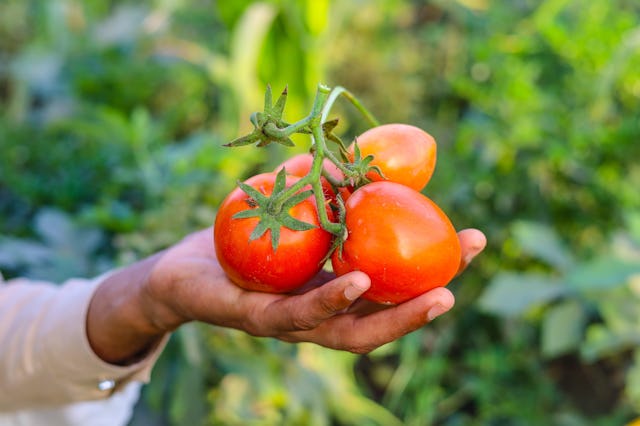How Do You Freeze Tomatoes? You’ve Got Choices, But It’s Easier Than You Probably Think
Keep the flavors of summer alive well into fall and winter.

There is literally nothing better than slicing a fresh tomato, sprinkling it with some salt, and enjoying one of the most quintessential summer flavors. If you have a green thumb, you get the joy of plucking those sun-ripened beauties right from the vine and enjoying the literal fruits of your labor in that colorful garden of yours. For the rest of us who have black thumbs, well, that's the beauty of the farmers market — you can buy a bushel every week if you want and savor this delightful produce all summer long. But what about the rest of the year? To keep the edible enjoyment going, you'll need to learn how to freeze tomatoes.
That might not have sounded appetizing a decade or so ago. However, plenty of gardeners, chefs, and food scientists have spent a ton of time experimenting with the best possible way to freeze tomatoes and trap in that summer-only fresh flavor. And, believe it or not, there are several solid freezing methods to try.
Which tomatoes freeze best?
All tomatoes freeze up nicely. However, many gardeners will tell you that the pulpier Roma tomatoes freeze the best. Beyond that, freezing tomatoes boils down to choosing the best tomatoes and making quick work of it. For optimal frozen tomatoes:
- Pick tomatoes that are firm and have a deep color.
- Your best tomatoes will be fragrant and feel heavy in your hands.
- Avoid tomatoes with any blemishes.
- If your tomatoes are picked before they're at peak ripeness, allow them to ripen on a counter or in the window first.
- Freeze them as quickly as possible once they're ripe.
Does freezing tomatoes make them mushy?
The answer, in short, is yes, but this can be especially helpful if you want to puree your tomatoes. When you freeze tomatoes, they do lose their texture because the pulp fibers expand and break down. This makes the tomatoes watery, which can reduce their flavor.
How To Freeze Tomatoes — Sliced
The University of Minnesota Extension offers the easiest solution to freezing sliced tomatoes.
"Slice tomatoes into at least 1/2-inch slices. Put slices on a cookie sheet and freeze for 2 hours. Remove slices and put them into freezer bags or containers," they suggest.
Freezing them on a cookie sheet first is vital for many reasons. It's particularly beneficial to freeze them on the cookie sheet first, as it helps to ensure they don't all freeze in a big clump. That means you can thaw one slice at a time, exactly when you're ready for it. It also helps you avoid wasting juice.
How To Freeze Tomatoes — Whole
There are two ways to freeze whole tomatoes: peeled or unpeeled. The University of Nebraska's Institute of Agriculture and Natural Resources has steps for both methods. Both methods start by selecting firm, ripe tomatoes, washing them under cold water, and drying them. Next, you'll want to cut around the stem scar and the surrounding area so you can remove and dispose of it.
For Unpeeled Tomatoes
Place whole tomatoes on a cookie sheet and freeze until solid, then remove and place into freezer bags or plastic containers and seal tightly.
For Peeled Tomatoes
"Dip tomatoes in boiling water for about 1 minute or until the skins split to peel easier," they suggest. Once their skins split, peel them. After that, you'll follow the same directions as above. Freeze first on a cookie sheet and then move to a freezer-safe container.
How To Freeze Tomatoes — Pureed
If you know you will primarily use your tomatoes in sauces or soups, you can go ahead and puree most of them immediately. Freezing the puree instead of the whole tomatoes takes up a lot less room in your freezer and will make your harvest less susceptible to freezer burn. If you want a thicker tomato puree (something more like the texture of a tomato paste), you can start by squeezing out your tomatoes in some cheesecloth and then pureeing what's left. For a puree that's "soupier" or "saucier," puree your tomatoes without squeezing out the excess juice.
Once you've made your puree, portion out serving or recipe-sized quantities into freezer bags, squeeze out all the air, seal tightly and then freeze flat. Once your sauce/puree is frozen, you can leave your bags stacked flat or stand them up.
This article was originally published on